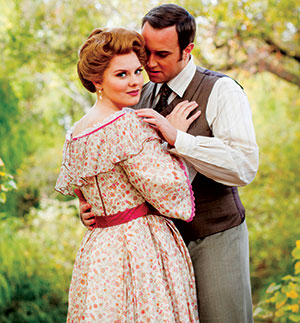

Let’s face it: with production costs high and public interest limited, the economics of producing opera in the United States are dicey at best. It’s no wonder many opera companies play it safe, packing their seasons with bankable works by big-name composers.
It is a bold choice, then, for Opera San Jose to mount a fully staged production of a brand new work by a little-known composer. But for opera fans who’ve had their fill of Aida, Don Giovanni and Madama Butterfly, it’s a welcome move.
Based on the novel by E.M. Forster, OSJ’s world-premiere production of Where Angels Fear to Tread boasts an exceptional orchestra and a superb cast, and is absolutely gorgeous to look at from beginning to end.
There is no mistaking the tremendous talent that has gone into every facet of this show, yet the result is less exciting than you might hope. Where Angels Fear to Tread is well-executed but overly safe—a new work that feels more comfortable than new.
Much of this is due to the source material. Forster’s novel shares key elements with a number of great Romantic operas—a woman in love with an unworthy man, the tragic death of an innocent, a chaotically passionate lifestyle glorified. But the quintessentially English standpoint through which these elements are viewed results in an opera that often feels pallid and emotionally distant.
As the show begins, Englishman Philip Herriton (tenor Kirk Dougherty) arrives in the Italian village of Monteriano, seeking to prevent his sister-in-law’s marriage to a handsome local from a decidedly middle-class family, only to discover that he is too late. Lilia (soprano Isabella Ivy) is madly in love with Gino (baritone Matthew Hanscom), and the pair has already wed—just hours earlier.
After Philip returns to England, Gino becomes abusive and controlling. When Lilia dies in childbirth, Philip comes to Italy once more, this time hoping to persuade the volatile Gino to turn the baby over to its English relatives. Philip is accompanied on this trip by his domineering, xenophobic sister, Harriet (mezzo Lisa Chavez), who is more than willing to take matters into her own hands. In Monteriano, the pair encounters Lilia’s friend, Caroline Abbott (soprano Christie Conover), who, feeling guilty for encouraging Lilia’s ill-fated marriage, has also come to “rescue” the child.
The libretto by Roger Brunyate is a workmanlike adaptation of the novel, keeping the major plot points essentially intact and rendering Forster’s flawed characters faithfully. More problematically, it also preserves Forster’s muddled tone and pedestrian narrative structure.
Mark Lanz Weiser’s neo-romantic score also plays it safe, eschewing the spiky 20th-century minimalism of John Adams and Michael Nyman, but also lacking the wild melodicism of Romantic-Era composers like Verdi and Puccini. The overture and scene-change music are reminiscent of Hollywood soundtracks from the 1950s: they are evocative and exquisitely scored, pastoral one moment and rhythmically foreboding the next. (OSJ’s scenic design reinforces this cinematic feel with an enormous sepia-tone map which descends at the curtain line to cover the scene shifts, much like the full-screen maps in old-timey films.)
Fully-fledged arias are scarce here, giving the singers few chances to truly show off their chops. Most of the vocal score consists of melodically flat recitatives and long, meandering duets. This may be by design—the composer’s attempt to mimic the introspective tone and conversational structure of Forster’s book—but it feels like navel-gazing, less palatable on the stage than on the page.
The score’s two best moments both belong to Caroline Abbott. Her rangey aria in the second act was the only piece in the show that drew a burst of show-stopping applause on opening night, and her lullabye later in the act is the most traditionally melodic song in Wieser’s score. (The third-best moment in OSJ’s production is the act one finale, a sextet in which a live dachshund on stage adds a furioso howling counterpoint to the human singers.)
All of the principal singers do admirable work, not just vocally but dramatically as well. As Gino, Matthew Hanscom has the toughest sell, and he comes as close as one could hope in achieving the story’s ultimate goal: making us admire the uncomplicated passions of a wholly unrepentant character.
Michael Ganio’s set and David Lee Cuthbert’s lighting create an environment that is nothing short of ravishingly beautiful, with conductor Joseph Marcheso’s orchestra adding subtle color and complexity. Ultimately, though, Where Angels Fear to Tread is a reminder that vast amounts of high-quality work do not always produce a satisfying whole.
Where Angels Fear To Tread


